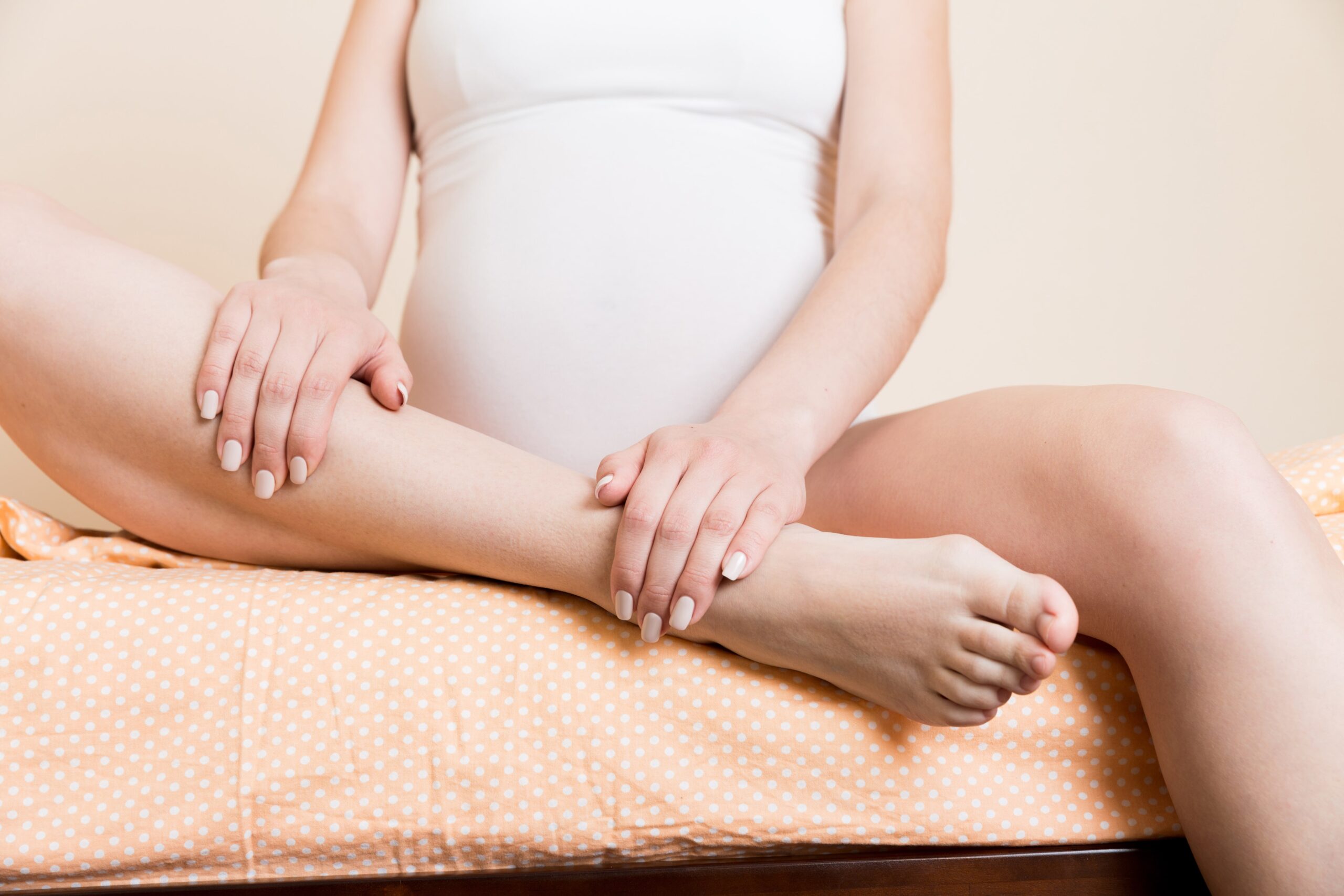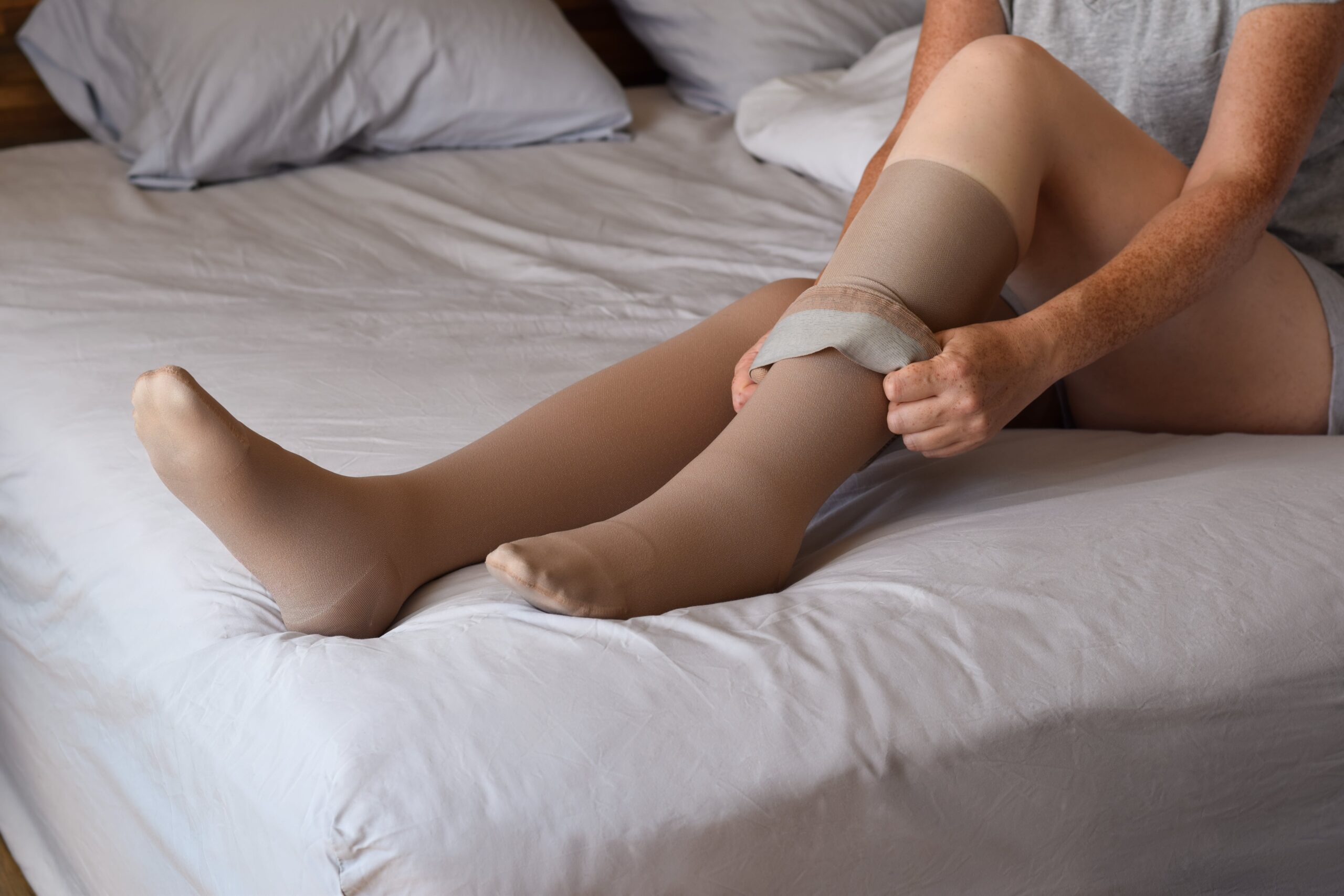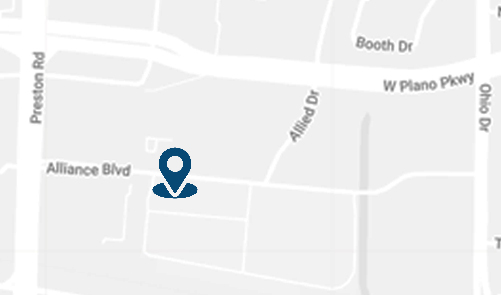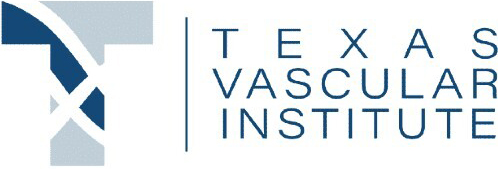By: Dr. Dev Batra | 01.06.26
Compression stockings have been a standard treatment for varicose veins for many decades, and are still prescribed today as a first-line therapy to manage symptoms and prevent the progression of chronic venous insufficiency (CVI).
While compression stockings can provide effective symptom relief for some, many patients find them uncomfortable and have a hard time staying compliant with their treatment plan. Even when patients strictly adhere to their compression therapy, stockings are unlikely to be a curative treatment for vein disease. These limitations can lead physicians to believe that they’re effectively managing their patients’ vein problems with a simple compression therapy prescription when in reality, vein disease may be progressing as it would without any prescription at all.
To help explain the role of compression therapy versus more effective vein treatments, we take a look at why compression stockings are prescribed, their limitations, and what the clinical evidence has taught us about their efficacy.
In this Article
- How compression stockings may help manage varicose veins
- The challenges and limitations of compression stockings for varicose veins
- The comparative data between compression stockings and curative vein treatments
How Compression Stockings Work
In a healthy vein, tiny valves along the course of the vein open and close to prevent backflow. As a person ages, the veins are subjected to stresses that can cause the valves to weaken and stop working, causing blood to flow backwards and pool in the veins. This phenomenon is called venous reflux and leads to a variety of symptoms like bulging varicose veins, spider veins, swelling, and cramping.
Compression stockings work by applying external pressure on the veins. However, unlike standard tight socks or hosiery, medical-grade stockings utilize graduated compression.
This means the pressure is strongest at the ankle—where gravity causes the most blood to pool—and gradually decreases as the stocking moves up the leg. This specific pressure gradient works against gravity, helping to squeeze the vein walls together and efficiently push blood upward toward the heart.¹ This mode of action eases the workload on your veins, alleviating symptoms and potentially preventing the worsening of vein disease.²

Choosing the Right Pressure Level (mmHg)
Not all compression stockings are created equal. The strength of the compression is measured in millimeters of mercury (mmHg), the same unit used to measure blood pressure. The higher the number, the stronger the squeeze.
Choosing the wrong pressure level is a common reason patients find stockings uncomfortable or ineffective. Here is a general guide to the different grades:
- Low Compression (8–15 mmHg): Available over-the-counter (OTC) without a prescription. These provide mild relief for tired, achy legs and are often used by healthy individuals who stand for work or want a slight boost in circulation.
- Medium Compression (15–20 mmHg): Also typically available OTC. This level is ideal for preventing minor swelling during travel (such as long flights), managing leg fatigue during pregnancy, or supporting legs with minor varicose veins.
- Medical Grade Class I (20–30 mmHg): This is the most frequently prescribed level for patients with medically diagnosed varicose veins, chronic venous insufficiency (CVI), or mild edema. It provides firm support to manage moderate symptoms and prevent the progression of vein disease.
- Medical Grade Class II & III (30–40+ mmHg): These are high-strength prescription garments. They are typically reserved for severe cases, such as managing active venous ulcers, severe lymphedema, or post-thrombotic syndrome after a DVT.
Note: You should always consult a vascular specialist before using stockings rated 20 mmHg or higher to ensure they are safe for your specific circulatory health.
Common Uses: Pregnancy, Travel, and Work
While compression stockings are a standard treatment for diagnosed vein disease, they are also highly effective tools for preventing vein damage in specific high-risk situations. You don’t need a diagnosis to benefit from the support they provide.
During Pregnancy
Pregnancy places a massive strain on the vascular system. Your blood volume increases significantly to support the baby, while pregnancy hormones naturally cause vein walls to relax and widen. This combination makes pregnant women highly susceptible to developing varicose veins and experiencing severe leg swelling. Wearing compression stockings during pregnancy can help counteract this increased pressure, reducing edema and lowering the risk of developing permanent vein damage.
Air Travel and Long Trips
Sitting for long periods in a car or airplane restricts blood flow and increases the risk of Deep Vein Thrombosis (DVT), often referred to as “economy class syndrome.” When you are confined to a seat, your calf muscles cannot pump blood effectively. Wearing knee-high compression stockings during travel applies the necessary pressure to keep blood circulating, preventing clots and reducing the “heavy leg” feeling upon arrival.

High-Risk Occupations
Your job may be hurting your veins. Professions that require prolonged standing (such as nurses, teachers, hair stylists, and retail workers) force your veins to fight gravity all day without rest. Conversely, desk jobs and truck driving require prolonged sitting, which can kink veins and stall circulation. For these workers, compression stockings act as an external support system, helping to energize the legs and prevent the evening fatigue and aching associated with occupational vein stress.
Who Should NOT Wear Compression Stockings? (Safety Warning)
While compression stockings are generally safe for most people, they are not suitable for everyone. Because they physically squeeze the leg to manipulate blood flow, they can be dangerous for individuals with certain underlying health conditions. You should never start a high-compression regimen without consulting a specialist if you have any of the following:
Peripheral Arterial Disease (PAD)
This is the most significant contraindication. While stockings help veins push blood out of the leg, they can obstruct arteries trying to bring oxygenated blood into the leg. If you have PAD (narrowing of the arteries), wearing compression stockings can severely restrict blood supply, potentially leading to ischemia (tissue death) or worsening claudication pain.
Peripheral Neuropathy and Diabetes
Patients with diabetes or peripheral neuropathy often have decreased sensation in their legs and feet. This is dangerous because they may not be able to feel if a stocking is too tight, bunched up, or cutting off circulation. Without that pain signal, a tight stocking could cause pressure sores, skin breakdown, or ulcers that the patient doesn’t notice until it is too late.
Active Skin Infections or Fragile Skin
If you have cellulitis, open untreated wounds, or extremely fragile skin (often called “tissue paper skin”), compression stockings can aggravate the issue. The fabric can trap bacteria against the skin, increasing the risk of infection, or cause friction that tears delicate tissue. In these cases, the skin must be fully healed or properly dressed by a wound care specialist before compression is applied.
Tips for Success: How to Wear Your Stockings
One of the main reasons patients abandon compression therapy is simply the struggle of getting the stockings on. Because they are designed to be tightest at the ankle, pulling them over the heel can feel like a wrestling match.
However, a few adjustments to your routine can make the process significantly easier and more comfortable.
Timing is Everything
The golden rule of compression therapy is to put your stockings on first thing in the morning, before you even get out of bed. During the night, your legs are elevated, meaning swelling is at its lowest point. Once you stand up and start moving, gravity pulls fluid into your legs, causing them to swell slightly. Trying to pull tight stockings over swollen legs later in the day is difficult and often painful.
Proper Technique: Avoid the “Tourniquet Effect”
A common mistake is treating compression garments like regular socks.
- Do not bunch them up: Instead, turn the stocking inside out down to the heel, slide your foot in, and then gradually unroll it up your leg.
- Never roll the top down: If the stocking feels too long, do not roll the excess fabric down at the top. This creates a tight band of double pressure (a tourniquet effect) that can dangerously cut off circulation rather than improve it.

Use Donning Aids and Tricks
If you have arthritis, limited flexibility, or simply find the fabric too stiff, consider using tools to help:
- Rubber Gloves: Wearing standard household rubber gloves gives you extra grip, allowing you to smooth the fabric up your leg without tearing it with your fingernails.
- Cornstarch or Powder: Dusting your legs with cornstarch or baby powder reduces friction, allowing the stocking to slide up over the skin more smoothly.
- Stocking Butlers: For those who cannot reach their feet, a “stocking butler” is a metal frame device that holds the stocking open for you, allowing you to step into it without bending over.
Compliance with Compression Stockings Can Be Challenging
Compression stockings are only effective while they are worn. Because swelling increases when sitting or walking, stockings must be worn throughout the entire day to have maximum benefit. Most physicians recommend wearing them throughout the day and only taking them off at night before sleeping. Care must be taken to not get them wet, and any open sores or ulcers that may be present on the legs must be cleaned and bandaged before putting on the stockings.
Many patients find that keeping up with compression therapy for varicose veins is difficult. A literature review published by the European Society of Vascular Surgery in 2017 found that patient compliance with compression stockings was only 66%, and patients were more likely to be compliant when prescribed lower degrees of compression. ³ The investigators of this review cited a number of reasons why patients have a hard time keeping up with compression therapy. Challenges include:
- Forgetting to wear stockings
- Difficulty putting stockings on
- Dissatisfaction with stocking appearance
- Discomfort wearing stockings on warm days
Another study found that compression stockings can cause a number of uncomfortable side effects,² including:
- Itchiness
- Numbness in the legs
- Sweating
- Pain related to stocking use
- Skin breakdown if the stockings are too tight
- Fungal infections if the skin is not cleaned properly or if an open wound is present
- Contact dermatitis if allergic to stocking material
Compression Stockings Do Not Cure Vein Disease
Studies examining both compression stocking therapy and venous surgery have demonstrated the differences in efficacy between passive management (compression) and proactive vein treatment (surgery). One such study done over two years in Finland showed that patients who underwent surgery had a significant reduction in symptoms and improvement in quality of life measures such as itching, appearance, ability to perform daily activities and swelling. And of the patients who underwent compression therapy alone, 36% of patients had opted to undergo vein surgery after the trial ended.⁴
Another way to look at the long-term effects of compression therapy is to examine their effect on venous stasis ulceration, the ‘end-stage’ complication of vein disease. One such randomized controlled trial published by The Lancet in 2004 compared compression stockings alone versus surgery and compression stockings. This trial, popularly called the ESCHAR trial, found no difference between the two therapies for ulcer healing within 24 weeks. However, patients who had gone through both superficial venous surgery and compression therapy had a 19-20% reduction of ulcer recurrence compared to compression therapy alone.⁵
While these studies looked at surgical vein treatment compared to compression stockings, these findings certainly apply to minimally invasive treatments like thermal vein ablation, VenaSeal, and ultrasound-guided foam sclerotherapy as well.⁶
Ultimately, the data highlights a clear distinction: compression stockings merely manage symptoms, while medical procedures address the root cause. To help you decide which path fits your goals and lifestyle, here is a direct comparison of the commitment and results required for each approach:
| Feature | Compression Stockings | Minimally Invasive Treatment (Ablation) |
|---|---|---|
| Goal | Manage Symptoms | Treat the Root Cause |
| Duration | Daily wear (often for life) | < 1 Hour Procedure |
| Effectiveness | Temporary relief only | 95%+ Success Rate |
| Cost | Ongoing (replacing pairs) | One-time (Insurance covered) |
Conclusion: Are Compression Stockings Effective in the Treatment of Varicose Veins?
Compression stockings may provide symptom relief and help prevent vein disease from worsening, but they require continuous use to be effective and do not address the underlying source of vein disease. Clinical studies have demonstrated that more proactive vein treatments are more effective than simple compression therapy. Taken together, these facts point to compression therapy as a very conservative treatment approach with a high likelihood of failure. And while the risks of compression therapy are minimal, the real risk is that effective vein treatment is delayed when we rely too heavily on compression stockings to provide effective long-term vein disease management.
At the Texas Vascular Institute, we tend to say that vein problems are very common and very treatable. Minimally invasive treatments like thermal vein ablation are more than 95% effective in treating varicose veins and resolving vein-related symptoms. ⁷ If you’ve had enough of compression stockings, it may be time to see a vein specialist.
About the Author
Dr. Dev Batra, M.D. is a vein specialist and founding partner of Texas Vascular Institute. Holding board certifications in radiology and vascular & interventional radiology, he is well-versed in vein issues and has been voted one of D-Magazine’s best doctors in Dallas for three years running.
This blog post was written with research and editorial assistance from OnChart.
References
[1] Rohan, C.P-Y., Badel, P., Lun, B., Rastel, D. & Avril, S. (2013). Biomechanical response of varicose veins to elastic compression: A numerical study. Journal of Biomechanics, 46:599-603.
[2] Motykie, G.D., Caprini, J.A., Arcelus, J.I., Reyna, J.J., Overom, E. & Mokhtee, D. (1999). Evaluation of therapeutic compression stockings in the treatment of chronic venous insufficiency. Dermatol Surgery, 25:116-120.
[3] Kankam, H.K.N., Lim, C.S., Fiorentino, F., Davies, A.H. & Gohel, M.S. (2017). A summation analysis of compliance and complications of compression hosiery for patients with chronic venous disease or post-thrombotic syndrome. European Journal of Vascular and Endovascular Surgery, 55:406-416.
[4] Sell, H., Vikatmaa, P., Albäck, A., Lepäntalo, M., Malmivaara, A., Mahmoud, O. & Venermo, M. (2014) Compression therapy versus surgery in the treatment of patients with varicose veins: A RCT. European Journal of Vascular and Endovascular Surgery, 47(6):670-677.
[5] Barwell, J.R., Davies, C.E., Deacon, J., Harvey, K., Minor, J., Sassano, A., Taylor, M., Usher, J., Wakely, C., Earnshaw, J.J., Heather, B.P., Mitchell, D.C., Whyman, M.R. & Poskitt, K.R. (2004). Comparison of surgery and compression with compression alone in chronic venous ulceration (ESCHAR study): randomized controlled trial. Lancet, 363:1854-59.
[6] Lohr, J., & Kulwicki, A. (2010). Radiofrequency Ablation: Evolution of a Treatment. Seminars in Vascular Surgery, 23(2), 90–100.
[7] Morrison, N., Gibson, K., Vasquez, M., Weiss, R., Cher, D., Madsen, M., & Jones, A. (2017). VeClose trial 12-month outcomes of cyanoacrylate closure versus radiofrequency ablation for incompetent great saphenous veins. Journal of Vascular Surgery: Venous and Lymphatic Disorders, 5(3), 321–330.
Medical Disclaimer
The Materials available in the Texas Vascular Institute blog are for informational and educational purposes only and are not a substitute for the professional judgment of a healthcare professional in diagnosing and treating patients.
Read more blogs
Fix Leg & Knee Pain
Fix leg and knee pain without surgery and stay active in 2026. Learn safe, minimally invasive treatments that help you keep moving.
Compression stockings for varicose veins
Struggling with compression stockings? Learn how to choose the right pressure (mmHg), tips for easier daily wear, and why they aren't a permanent cure.
7 Signs of Vein Damage
Do your legs feel heavy, achy, or itchy? Learn the 7 signs of vein damage, from spider veins to ulcers, and how Dr. Batra treats the root cause.
WHAT OUR PATIENTS
have to say
Texas Vascular Institute always appreciates feedback from our valued patients. To date, we’re thrilled to have collected 378 reviews with an average rating of 5 out of 5 stars. Please read what others are saying about Texas Vascular Institute below, and as always, we would love to collect your feedback.
Leave a Review
Amazing Practice
I'm very particular with my Healthcare and tend to be cautious with referrals to specialists. This office is amazing from the first point of contact. Their staff are friendly, professional and highly knowledgeable. Then the Dr is just as amazing as his staff, absolutely brilliant. Office manager Jessica has this office running like a well oiled machine and does so with a smile, an air of confidence, kindness and professionalism. Love this practice!!
- Richard G.

Beyond Thankful
Dr Batra and his staff are amazing! We are so grateful to have found him. Everyone is so kind and so caring and Dr Batra explains everything so well and does procedures with excellence. Beyond thankful to be under their care!!!
- Bitsy P.

Gold Standard
This is a gold standard for how a medical practice should be run. I was promptly seen at my scheduled time, my ultrasound was thorough and I received plenty of attention and care from the staff and Dr.Batra.
- Weronika L.
INSURANCE
We accept most major insurance plans. Please contact the medical office for all insurance related questions.









8330 Meadow Rd #100
Dallas, TX 75231
For Appointments: 972-798-4710
General Inquiries: 972-646-8346

809 West Harwood Rd, Suite 101,
Hurst, TX 76054
For Appointments: 972-798-4710
General Inquiries: 972-646-8346

4716 Alliance Blvd Suite #180,
Plano, TX 75093
For Appointments: 972-798-4710
General Inquiries: 972-646-8346

